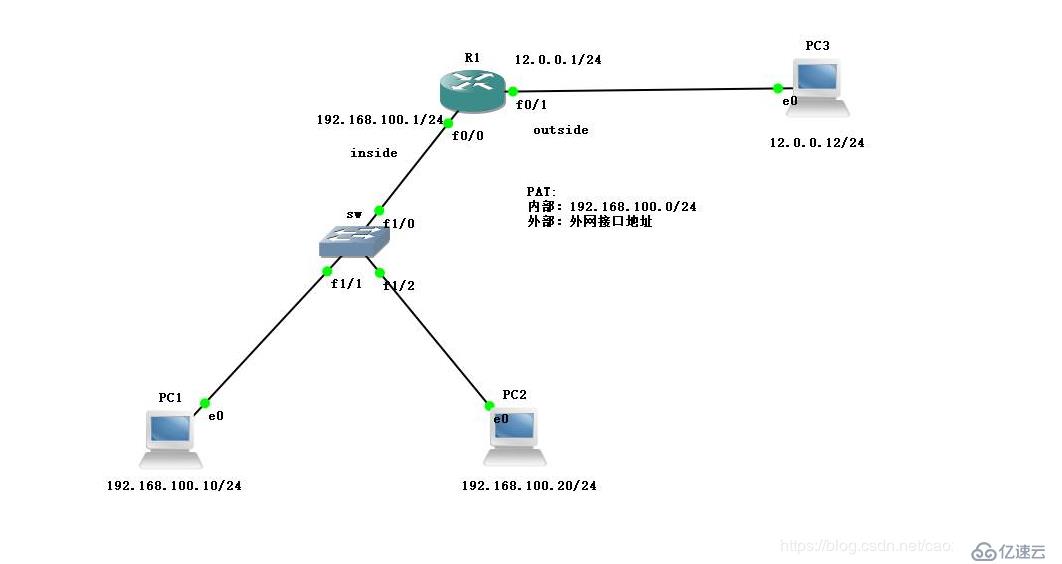
sw#conf t
sw(config)#no ip routing //关闭路由功能
sw(config)#int f1/0
sw(config-if)#speed 100 //配置速率
sw(config-if)#dup full //配置全双工模式
sw(config-if)#exR1#conf t
R1(config)#int f0/0
R1(config-if)#ip add 192.168.100.1 255.255.255.0
R1(config-if)#no shut
R1(config-if)#int f0/1
R1(config-if)#ip add 12.0.0.1 255.255.255.0
R1(config-if)#no shut
R1(config-if)#ex
R1(config)#access-list 1 permit 192.168.100.0 0.0.0.255
//定义内部访问列表
R1(config)#ip nat inside source list 1 interface fastEthernet 0/1 overload
//设置复用动态IP地址转换于外部接口
R1(config)#int f0/0
R1(config-if)#ip nat inside
R1(config-if)#int f0/1
R1(config-if)#ip nat outside
R1(config-if)#endPC1> ip 192.168.100.10 192.168.100.1
Checking for duplicate address...
PC1 : 192.168.100.10 255.255.255.0 gateway 192.168.100.1
PC2> ip 192.168.100.20 192.168.100.1
Checking for duplicate address...
PC1 : 192.168.100.20 255.255.255.0 gateway 192.168.100.1
PC3> ip 12.0.0.12 12.0.0.1
Checking for duplicate address...
PC1 : 12.0.0.12 255.255.255.0 gateway 12.0.0.1PC1> ping 12.0.0.12
84 bytes from 12.0.0.12 icmp_seq=1 ttl=63 time=31.242 ms
84 bytes from 12.0.0.12 icmp_seq=2 ttl=63 time=46.864 ms
84 bytes from 12.0.0.12 icmp_seq=3 ttl=63 time=31.280 ms
84 bytes from 12.0.0.12 icmp_seq=4 ttl=63 time=31.241 ms
84 bytes from 12.0.0.12 icmp_seq=5 ttl=63 time=31.241 ms
R1#debug ip nat
IP NAT debugging is on
R1#
*Mar 1 00:32:57.215: NAT*: s=192.168.100.10->12.0.0.1, d=12.0.0.12 [59174]
*Mar 1 00:32:57.219: NAT*: s=12.0.0.12, d=12.0.0.1->192.168.100.10 [59174]
...
//私网地址192.168.100.10已转换成功公网地址12.0.0.1,并接收到来自公网主机的回复信息
PC2> ping 12.0.0.12
84 bytes from 12.0.0.12 icmp_seq=1 ttl=63 time=31.242 ms
84 bytes from 12.0.0.12 icmp_seq=2 ttl=63 time=31.245 ms
84 bytes from 12.0.0.12 icmp_seq=3 ttl=63 time=31.244 ms
84 bytes from 12.0.0.12 icmp_seq=4 ttl=63 time=31.213 ms
84 bytes from 12.0.0.12 icmp_seq=5 ttl=63 time=31.246 ms
R1#
*Mar 1 00:35:15.595: NAT*: s=192.168.100.20->12.0.0.1, d=12.0.0.12 [59312]
*Mar 1 00:35:15.607: NAT*: s=12.0.0.12, d=12.0.0.1->192.168.100.20 [59312]
...
////私网地址192.168.100.20已转换成功公网地址12.0.0.1,并接收到来自公网主机的回复信息| 内部地址 | 外部地址 |
|---|---|
| 内部局部地址 (端口) | 内部全局地址(端口) |
| 外部局部地址 | 外部全局地址(端口) |
1.动静态NAT无法解决ip地址匮乏问题 (默认一个私网IP地址对一个公网IP地址)
2.PAT却可以解决ip地址匮乏(多个私网IP地址对一个公网IP地址)
免责声明:本站发布的内容(图片、视频和文字)以原创、转载和分享为主,文章观点不代表本网站立场,如果涉及侵权请联系站长邮箱:is@yisu.com进行举报,并提供相关证据,一经查实,将立刻删除涉嫌侵权内容。